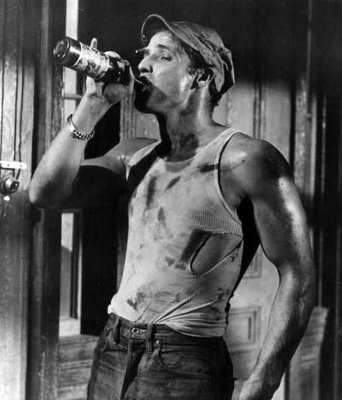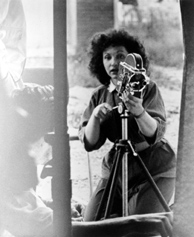"I know I fib a good deal. After all,
a woman's charm is 50% illusion. "
-Blanche DuBois
In many scenes throughout the film, we witness a disgruntled Stanley (Brando) eating with his mouth open or drinking alcohol with his poker buddies. These props make us feel as though we are watching someone’s possible real life in front of us, not someone acting out a scripted play. With Brando’s method acting he turns a simple dinner into a fight that could happen anywhere.
 The character, Blanche DuBois, played by Oscar winner Vivien Leigh, always uses multiple props to give her character depth. I noticed that whenever Blanche is in a flirty mood she always asks a man for a cigarette. The cigarette is almost like her security blanket. It gives her something to hold on too, feel comforted by and allows her to be the seducer she really is. She constantly is flirting with Stanley who happens to be her sister’s husband when she has a cigarette in her hand. When she first asks for a cigarette, Stanley gives her one from behind his ear. This was adding his person touch to it and flirting back to her. When Blanche asks Mitch, a suitor she seems to be interested in, though he’s more interested than she, for a cigarette, he reaches for one in his shiny silver case. She sees his case and it opens up a conversation for both of them. This use of prop creates the focal point of Blanche and her character.
The character, Blanche DuBois, played by Oscar winner Vivien Leigh, always uses multiple props to give her character depth. I noticed that whenever Blanche is in a flirty mood she always asks a man for a cigarette. The cigarette is almost like her security blanket. It gives her something to hold on too, feel comforted by and allows her to be the seducer she really is. She constantly is flirting with Stanley who happens to be her sister’s husband when she has a cigarette in her hand. When she first asks for a cigarette, Stanley gives her one from behind his ear. This was adding his person touch to it and flirting back to her. When Blanche asks Mitch, a suitor she seems to be interested in, though he’s more interested than she, for a cigarette, he reaches for one in his shiny silver case. She sees his case and it opens up a conversation for both of them. This use of prop creates the focal point of Blanche and her character.
 Another prop predominately used by Blanche, is her constant use of looking in the mirror. She is forever looking at the mirror to admire her reflection. To me, this use of prop was to show us that Blanche is flawed just like everyone else. She is insecure about her appearance because she is getting older and becoming less attractive to men her own age. When we see her look in the mirror, she is always fixing something about her look; she is not as perfect as she would like us to believe. Towards the end of the film when she and Stanley begin to argue, she looks in the mirror as if asking for advice on what she should do next. She is betting on the mirror being her conscience and guide. Stanley doesn’t see what she sees and becomes enraged and breaks the mirror. All hope she once had is now gone and broken into a million little pieces. She no longer is stable and her life forever changes. Her true self comes to light.
Another prop predominately used by Blanche, is her constant use of looking in the mirror. She is forever looking at the mirror to admire her reflection. To me, this use of prop was to show us that Blanche is flawed just like everyone else. She is insecure about her appearance because she is getting older and becoming less attractive to men her own age. When we see her look in the mirror, she is always fixing something about her look; she is not as perfect as she would like us to believe. Towards the end of the film when she and Stanley begin to argue, she looks in the mirror as if asking for advice on what she should do next. She is betting on the mirror being her conscience and guide. Stanley doesn’t see what she sees and becomes enraged and breaks the mirror. All hope she once had is now gone and broken into a million little pieces. She no longer is stable and her life forever changes. Her true self comes to light.
A Streetcar Named Desire. Director Elia Kazan. Starring Marlon Brando, Vivien Leigh, Kim Hunter, Karl Madden. 1951. Warner Home Video. DVD.
IMDB- A Streetcar Named Desire
Mirror Picture
Brando Picture
Vivien Leigh-Cigarette
Corrigan & White (2009), The Film Experience: An Introduction.
While watching A Streetcar Named Desire (1951), I not only noticed Marlon Brando’s method acting but the use of props in the film. The mis-en-scene would not be complete without either. Without props, I wonder what Dorothy would be like without her ruby red slippers or Darth Vader without his black helmet or Psycho (1960) without its infamous knife shower scene.
In many scenes throughout the film, we witness a disgruntled Stanley (Brando) eating with his mouth open or drinking alcohol with his poker buddies. These props make us feel as though we are watching someone’s possible real life in front of us, not someone acting out a scripted play. With Brando’s method acting he turns a simple dinner into a fight that could happen anywhere.
 The character, Blanche DuBois, played by Oscar winner Vivien Leigh, always uses multiple props to give her character depth. I noticed that whenever Blanche is in a flirty mood she always asks a man for a cigarette. The cigarette is almost like her security blanket. It gives her something to hold on too, feel comforted by and allows her to be the seducer she really is. She constantly is flirting with Stanley who happens to be her sister’s husband when she has a cigarette in her hand. When she first asks for a cigarette, Stanley gives her one from behind his ear. This was adding his person touch to it and flirting back to her. When Blanche asks Mitch, a suitor she seems to be interested in, though he’s more interested than she, for a cigarette, he reaches for one in his shiny silver case. She sees his case and it opens up a conversation for both of them. This use of prop creates the focal point of Blanche and her character.
The character, Blanche DuBois, played by Oscar winner Vivien Leigh, always uses multiple props to give her character depth. I noticed that whenever Blanche is in a flirty mood she always asks a man for a cigarette. The cigarette is almost like her security blanket. It gives her something to hold on too, feel comforted by and allows her to be the seducer she really is. She constantly is flirting with Stanley who happens to be her sister’s husband when she has a cigarette in her hand. When she first asks for a cigarette, Stanley gives her one from behind his ear. This was adding his person touch to it and flirting back to her. When Blanche asks Mitch, a suitor she seems to be interested in, though he’s more interested than she, for a cigarette, he reaches for one in his shiny silver case. She sees his case and it opens up a conversation for both of them. This use of prop creates the focal point of Blanche and her character. Another prop predominately used by Blanche, is her constant use of looking in the mirror. She is forever looking at the mirror to admire her reflection. To me, this use of prop was to show us that Blanche is flawed just like everyone else. She is insecure about her appearance because she is getting older and becoming less attractive to men her own age. When we see her look in the mirror, she is always fixing something about her look; she is not as perfect as she would like us to believe. Towards the end of the film when she and Stanley begin to argue, she looks in the mirror as if asking for advice on what she should do next. She is betting on the mirror being her conscience and guide. Stanley doesn’t see what she sees and becomes enraged and breaks the mirror. All hope she once had is now gone and broken into a million little pieces. She no longer is stable and her life forever changes. Her true self comes to light.
Another prop predominately used by Blanche, is her constant use of looking in the mirror. She is forever looking at the mirror to admire her reflection. To me, this use of prop was to show us that Blanche is flawed just like everyone else. She is insecure about her appearance because she is getting older and becoming less attractive to men her own age. When we see her look in the mirror, she is always fixing something about her look; she is not as perfect as she would like us to believe. Towards the end of the film when she and Stanley begin to argue, she looks in the mirror as if asking for advice on what she should do next. She is betting on the mirror being her conscience and guide. Stanley doesn’t see what she sees and becomes enraged and breaks the mirror. All hope she once had is now gone and broken into a million little pieces. She no longer is stable and her life forever changes. Her true self comes to light. The entire mis-en-scene of this film creates this fake world that seems so real. The props used throughout the film create the illusion that this could really happen. Ask any smoker and they’ll tell you they feel naked and lost without a cigarette in their hand. We all look in the mirror to make sure we look presentable in public. But do we really see the reflection that’s there? Or is it what we want to see?
A Streetcar Named Desire. Director Elia Kazan. Starring Marlon Brando, Vivien Leigh, Kim Hunter, Karl Madden. 1951. Warner Home Video. DVD.
IMDB- A Streetcar Named Desire
Mirror Picture
Brando Picture
Vivien Leigh-Cigarette
Corrigan & White (2009), The Film Experience: An Introduction.










